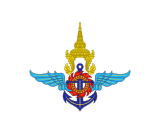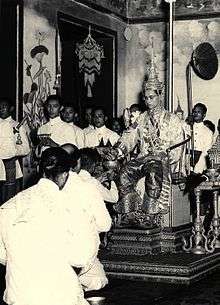Great Crown of Victory
The Great Crown of Victory (Thai: พระมหาพิชัยมงกุฏ; rtgs: Phra Maha Phichai Mongkut) is part of the Regalia of Thailand. Made of gold in the reign of King Rama I in 1782, the crown is 26" (66 centimeters) high and weighs 16 lb (7.3 kg), and enamelled in red and green. Thanks to King Rama IV, the crown is also set in diamonds. He added a large cut diamond from India to decorate the top of the crown, called Great Diamond (พระมหาวิเชียรมณี Phra Maha Wichian Mani). The crown is of a distinctive Thai design, being a multi-tiered conical diadem, terminating in a tapering spire.
A king only wears the crown during his coronation, where he places the crown on his own head. The shape of the crown represents the concept of divine monarchy. The tall spire represents divine authority and right to rule over the people.
Currently, the Great Crown of Victory is the most important of the five regalia, yet once the crown possessed the same importance as any other regalia. However, it was under the influence of western culture that the king would accede to the throne when crowned, in the reign of King Rama V.
Gallery
.svg.png) The Great Crown of Victory (heraldic version)
The Great Crown of Victory (heraldic version) The Great Crown of Victory (heraldic version), drawn by Hugo Gerard Ströhl
The Great Crown of Victory (heraldic version), drawn by Hugo Gerard Ströhl.svg.png) The privy seal of King Mongkut (Rama IV), depicting the Great Crown of Victory.
The privy seal of King Mongkut (Rama IV), depicting the Great Crown of Victory. Flag of the Minister of Defence of Thailand since 1936.
Flag of the Minister of Defence of Thailand since 1936..jpg) A replica of the Great Crown of Victory for the mast of the royal yacht Mahachakri II, Royal Thai Naval Museum, Samut Prakan.
A replica of the Great Crown of Victory for the mast of the royal yacht Mahachakri II, Royal Thai Naval Museum, Samut Prakan. King Bhumibol Adulyadej wearing the Great Crown of Victory on his coronation day at the Grand Palace, 5 May 1950.
King Bhumibol Adulyadej wearing the Great Crown of Victory on his coronation day at the Grand Palace, 5 May 1950. "The Great Crown of Victory", "exhibit" on Ratchadamnoen Avenue in Bangkok showing the Thai Regalia in honour of the 60th anniversary of King Bhumibol Adulyadej's accession to the throne in 2006.
"The Great Crown of Victory", "exhibit" on Ratchadamnoen Avenue in Bangkok showing the Thai Regalia in honour of the 60th anniversary of King Bhumibol Adulyadej's accession to the throne in 2006.
References
| Wikimedia Commons has media related to Crowns of Thailand. |